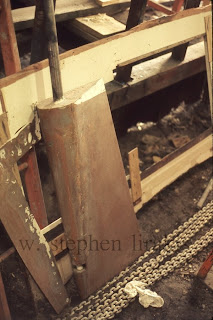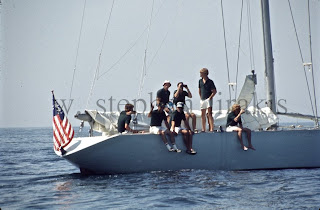I assembled this a few years ago because even I forget some of the boats and events I sailed. Still fond memories; and still making more.
Category: heritage
THE AMERICA’S CUP JUBILEE
I had the great privilege to sail “Columbia” the first twelve meter to defend the America’s Cup in 1958. at the America’s Cup Jubilee. There were 38 twelve meters there. This was a celebration of the 150th anniversary of the America’s Cup.
The idea of the Royal Yacht Squadron, from my prospective it exceeded all expectations. It was an endless parade of yachts each more beautiful and graceful the the next.
12 METER RACING IN SAN FRANCISCO BAY ?

There will be smiles around San Francisco Bay with the announcement that America’s Cup style racing is set to return to the venue of the 34th America’s Cup.
A bold plan by Tom Ehman, whose experience with the Cup dates back to 1977, will see racing resume on an annual basis in updated 12 Metre yachts – which were the preferred Cup class from 1956 to 1987.
The new event will reflect the true spirity of the America’s Cup Deed of Gift, with competition being between yacht club teams comprised only of nationals from that club’s country.
The new event is being masterminded by Tom Ehman who is currently the Vice Commodore of the Golden Gate Yacht Club, the body charged under the 19th century Deed of Gift, which governs the conduct of the America’s Cup, with the organisation of the 35th America’s Cup.
The America’s Cup Events Authority is the body responsible under the Protocol for the organisation of the next Match, but it created a great deal of angst amongst the San Francisco sailing fraternity when it decided not to Defend in its home waters, and took the Cup Defence to Bermuda.
That frustration has spawned the new event, coupled with the desire of San Francisco sailors to maintain their place on the international sailing vista.
Unlike the America’s Cup the new San Francisco event will carry half a million dollars in prizemoney, and will be a lot lower costs of entry, with a figure of $1million being touted as the annual cost to run a team.
The benefit for sponsors is that they will get annual exposure for their outlay, as opposed to the once every three/four years with the current Cup plus what can be obtained from the America’s Cup World Series – a three day event which will be sailed three times this year, and with only three venues announced for 2016
Speaking with Associated Press, Ehman said he envisions the Golden Gate Challenge as the Wimbledon of yacht racing in that it will be held every year at the same venue. Unlike the America’s Cup, all teams will be challengers, meaning they’ll start on equal footing each year.
To be named the Golden Gate Yacht Racing Challenge, the new event is being launched at a time when many in the sailing world have questioned the vision for the 35th America’s Cup of Larry Ellison and Russell Coutts, which has so far lost two of its Challengers of Record in the first 18 months of the 35th America’s Cup cycle.
Ehman said he hopes to attract team owners who have been priced out of the America’s Cup or turned off by recent turmoil.
‘This is an opportunity to do something for the sport and the former cup community,’ Ehman said from San Francisco.
Ehman told Bernie Wilson of the Associated Press that he’s working to secure event sponsors and teams.
‘I think this is the best venue in the world for showcasing yacht racing and that was shown in the last cup,’ he said. ‘There’s a crying need in the world of yacht racing for such an event, especially in monohulls and especially in a lot of breeze. We’re seeing that because of what’s happening or not happening in other parts of the sport and in other parts of the world.’
The move is sure to raise the hackles of the America’s Cup Events Authority, a privately owned company charged by the Golden Gate Yacht Club with the commercial and event management activities surrounding the 35th America’s Cup, now removed to Bermuda.
Technically Ehman is part of a management structure to which ACEA reports, however his position is also understood to be voluntary, and ACEA would have few options open to shut down this new initiative or Ehman’s involvement in promoting a new sailing event in a venue deserted by ACEA.
Ehman remains vice commodore of the Golden Gate Yacht Club, which is the America’s Cup trustee. He said his regatta is not affiliated with the GGYC and won’t compete with the America’s Cup. It is believed the new event will be hosted by all Bay area yacht clubs, and existing facilities will be used for team bases
‘I think the America’s Cup is off on its own and always has been,’ Ehman said. ‘The America’s Cup will survive the current situation. There is obviously strong interest in monohull racing with strong teams, in boats everyone has heard of and loves. There is a nostalgia and romance with the 12-meters, and to have those boats racing in a lot of breeze on San Francisco Bay where people can watch it, it will remind people of how great the America’s Cup was in Fremantle in 1987 in windy conditions in 12s.’
Ehman told AP that he’s having designers look at modernizing the 12s and hopes to keep the cost below $3 million per boat. All boats would have the same hull shape, which would make the regatta a test of sailing skill rather than a design competition, helping to hold down costs.
If a little is good, more is better America’s cup 1970
1970 brought more changes to the America’s cup. The story merits to be broken into segments, chapters if you like. The Americans have three boats: “Intrepid”, “Valiant” and “Heritage”. Ted Turner brings “American Eagle”, however she is not a real contender. Turner has raced her hard across the Atlantic, SORC, Annapolis-Newport; she was an ocean racing boat with milage.
As alluded to previously, Olin Stephens and others noted that displacement seemed to be good, while also recognizing that wetted surface was not. The eternal battle in displacement boats. “Valiant” represented the latest thinking by S&S, heavy, lots of bustle, short ends. This proved to be wrong, and S&S subsequently backed away from this direction.
Britton Chance, probably best known for his 5.5 meter successes at this point, re-designed “Intrepid” again, increasing the bustle, shortening the keel, and reducing the size of the rudder.
Charlie Morgan designed, built, skippered, and made the sails for “Heritage” Too much for one man to handle in an America’s Cup season.
As we all know “Intrepid” went on to become the second two time defender in 1970. The story of how she arrived there is an interesting one. Bill Ficker the skipper and helmsman it took all of his concentration to sail “Intrepid” with such a small rudder. The top half of her mast was titanium (the top two-thirds of “Valiant’s mast was titanium) with no jumpers. Low windage and low weight. The need for more control of both the mast and steering the boat would be re-visited later.
I must have photos of “Heritage”, as I worked on the shore crew under Paul Coble. 1970 was my final year in college, where we were ranked number 2 in the country, we certainly won our share. I arrived the morning of the Bermuda race from Wisconsin, site of the Intercollegiate national championships. Won the Bermuda Race aboard “Carina”; returning to Newport to work on Heritage.
I have not talked about the Challengers and will do in the next installment.






